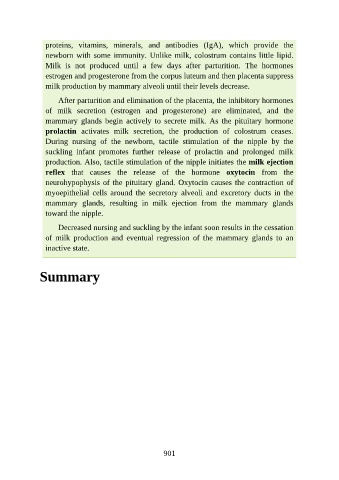Page 902 - Atlas of Histology with Functional Correlations
P. 902
proteins, vitamins, minerals, and antibodies (IgA), which provide the
newborn with some immunity. Unlike milk, colostrum contains little lipid.
Milk is not produced until a few days after parturition. The hormones
estrogen and progesterone from the corpus luteum and then placenta suppress
milk production by mammary alveoli until their levels decrease.
After parturition and elimination of the placenta, the inhibitory hormones
of milk secretion (estrogen and progesterone) are eliminated, and the
mammary glands begin actively to secrete milk. As the pituitary hormone
prolactin activates milk secretion, the production of colostrum ceases.
During nursing of the newborn, tactile stimulation of the nipple by the
suckling infant promotes further release of prolactin and prolonged milk
production. Also, tactile stimulation of the nipple initiates the milk ejection
reflex that causes the release of the hormone oxytocin from the
neurohypophysis of the pituitary gland. Oxytocin causes the contraction of
myoepithelial cells around the secretory alveoli and excretory ducts in the
mammary glands, resulting in milk ejection from the mammary glands
toward the nipple.
Decreased nursing and suckling by the infant soon results in the cessation
of milk production and eventual regression of the mammary glands to an
inactive state.
Summary
901

